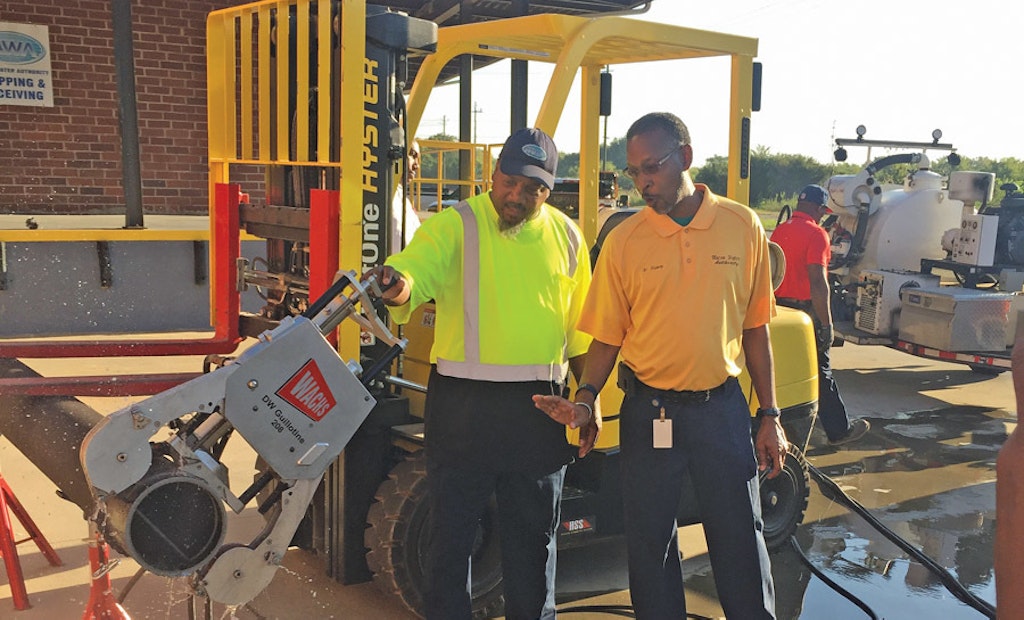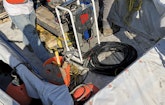
Utilities crews are able to cut pipe more efficiently and with less risk of injury over some other methods with the Diamond Wire Guillotine pipe saw from Wachs Utility.
Interested in Infrastructure?
Get Infrastructure articles, news and videos right in your inbox! Sign up now.
Infrastructure + Get Alerts"Zero days since our last injury" is a sign no municipal crew wants to see. And after a couple injuries to service workers while on the job, the utilities crew in Cocoa, Florida, knew they needed a safer way to cut pipes when fixing and installing water mains.
They found their solution about five years ago when Chris Collier, the assistant utilities director for Cocoa, learned of the Wachs Utility Diamond Wire Guillotine pipe saw and knew the tool needed to be in their arsenal. “Initially my crew thought it was just a new fad,” Collier says. “But I told them they can’t say that until they’ve used it and given it a chance.” And that’s exactly what they did.
Brandon Cox, water field operations assistant manager for the City of Cocoa, oversees six line crews that deal with main breaks and waterline maintenance daily. He agreed that something needed to change to make a safer work environment. “We were looking for a saw that was safer for our guys,” says Cox. “It was Chris who found the saw and said we need to check it out. After a demo from Wachs, I definitely agreed.”
After the demo, they purchased the Diamond Wire Guillotine 416 pipe saw and have been using it ever since. “We purchased the larger model right away to cut larger main pipe and we liked it so much that when they came out with the smaller DWG 208 version, we made sure to purchase one of those too,” Cox says.
Engineered safe
Wachs’ intention with the Diamond Wire Guillotine series was to build a saw that was safe and efficient. They utilize a fully enclosed, high-speed, high-density diamond-infused cutting wire specifically made to cut pipe and bar accurately and efficiently. The cutting wire is enclosed in a housing made from stainless steel and aluminum to protect the user while remaining corrosion resistant. The saws secure to the line using a chain mounting system to eliminate the possibility of kickback accidents.
They are hydraulically powered and because they run in a sealed loop, the saws can operate in extreme conditions like partial or full water immersion. “It really does makes nice clean cuts. It doesn’t matter if there is still water in the main, you can still cut, so you don’t need a complete shutdown,” Cox says.
Originally, Wachs only carried the DWG 416 model that is capable of cutting 4- to 16-inch pipes but has since come out with the 208 model that is more compact and used for 2- to 8-inch lines. Though Cox and his crews use both, he says the smaller version tends to be their go-to, due to its ease of use. “With the 208 model, one person can take it right down in the hole and mount it to the water main by themself,” he says. “The larger 416 model is very manageable, but often takes two people.
“Before these saws, for pipes larger than 6 inches we had people laying down there on their bellies, cutting windows and we had a couple kickback incidents over the years.”
The addition of the Guillotines took a lot of those unfavorable cutting strategies out of the picture for his crews.
Built to be efficient
Cox says there are few jobs they don’t take their vacuum trailer to, so their fabrication team figured out a way to mount a saw to the rig.
“We mounted the model 208 to our pull-behind vacuum trailer that has hydraulic capabilities so the guys can easily take it to the job with them and everything they need is right there,” he says. “On most main breaks, we are taking the vacuum trailer out. Mounting the saw to the vac makes it convenient so the team doesn’t have the excuse that they forgot the saw. It’s pretty much on all the jobs then.”
Wachs built the series for one-person setup and control capability. Each unit can connect to any standard Class II Hydraulic Power Unit, includes top-mounted controls for wire speed and feed and comes standard with quick-release levers and latches for easy setup and maintenance.
“It’s really easy to train new workers on, too,” Cox says. “The hardest part is getting it attached to the main, getting the angle right and making sure it’s straight, but once you do it one time, you’re pretty much set and ready to go from there.”
The ease-of-use features permit users to adapt on the job, a necessary capability when fixing main breaks. “It really covers a lot of different uses and applications. It never fails that there is a cable running over the top of the main, or something unforeseen, but you can just lay the saw over on the side a little and still make the cut.”
When the job is done, the next step for Cox and his crews is some routine upkeep. “They are simple to clean. When we are done with it, we bring it back to the yard and open it up to hose out the rocks and dirt or whatever may be in it, hit it with a little lubricant around pulleys and put it back on the truck. That’s it.”
Safety on the job site is a top priority and comes from proper training and providing the right tools. The Diamond Wire Guillotine pipe saw was made with that in mind. Wachs believes that safety and efficiency can be intertwined, and that the DWG series is a great example of just that.








